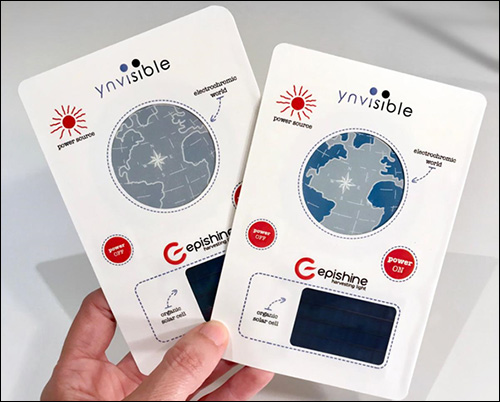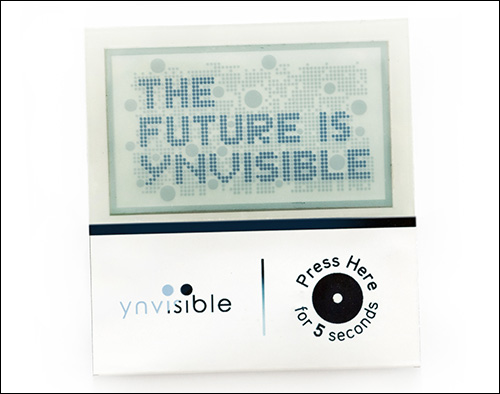Canada-based printed electronics company Ynvisible Interactive has developed a printed electronics display that the company envisions solving a problem for RFID technology. Its displays can already leverage RFID interrogation to supply the low amount of power required to energize them, but they also provide an automatic visual indication of an event, such as a temperature excursion, that could augment an RFID sensor, since they can be viewed without a reader. The result could be a solution that employs RFID to transmit a unique ID number and sensor data to a server—and for those without a reader, it could also provide a visual indicator that a tagged item requires attention.
Ynvisible’s core technology is its electrically driven display, consisting of a flat surface with a visual indicator, and using electrochromic (EC) printed electronics. With a very low current, the system allows users to create visual changes on the surface, according to Samuli Stromberg, the company’s head of business development. It’s a reflective display technology unlike a light-emitting system, he says, so power use is lower, the electronics are simpler and there is no glowing light.

Everyday items that might benefit from a visual indicator are the company’s target. The system could replace commonly used LED light indicators, Stromberg explains. Such lights can be annoying, he says, and do not provide printed information or instructions. “The applications currently have no way of indicating a visual change,” Stromberg notes, but it can be possible with this system. For instance, when attached to a sensor, the screen can change the display if it detects a change in an environment. The company cites a simple use case: a house plant. A sensor attached to a flower pot could detect moisture in the soil and display a smiley face on its surface. If the soil were to become too dry, the smile would turn to a frown.
RFID- and Near Field Communication (NFC)-based systems could also benefit from the technology, Ynvisible’s management believes, since the results of sensor measurements could be stored and transmitted via RFID, but they could provide simple visual indications for places or times at which RFID reading would not be possible or convenient. “We feel there is a very natural fit with RFID applications,” Stromberg states. First and foremost, RFID is already being built into the technology for power harvesting. But now, it is also testing the technology for RFID applications in which human-readable, dynamic changes, visible on the label, would benefit an RFID system.
Temperature-sensing NFC labels could be one example. If NFC tags with temperature-sensing functionality were attached to products, they would each collect temperature data, which could be captured via an NFC-enabled mobile phone or reading device. That data would then be stored on a server, where it could then be interpreted, shared and analyzed. But in the supply chain, as goods move throughout a warehouse, for instance, workers are unlikely to individually read each tag with a reader. A visual indicator that a product’s tag has captured a temperature outside of acceptable parameters could attract an employee to that product. “You could say we increase the read range of NFC,” Stromberg says, since the tag screen could be viewed at the distance the human eye can see.
In some cases, the last stop of a tagged item is also challenging for RFID use, because at that last transaction—such as in a store or upon the receipt of goods—there may be no NFC, HF or UHF RFID reader available. For instance, if vaccinations for patients in a third-world country were being sent to clinics, Ynvisible’s printed circuit indicator could provide visual information indicating that the conditions for that item had met requirements, or may have not have been healthy (if the vaccine became too warm, for example). Or, at a store at which no one would be reading RFID tags, the system could enable more use cases, since the last stop might not need to be equipped with RFID readers. Retail consumers could view indications of any temperature or moisture excursions, for instance.
The company is currently testing this functionality with RFID tags and plans to meet with RFID companies to determine how the technologies could be married together. “There’s a possibility to make things more clearly, visually understandable,” Stromberg says. Initially, however, it is using RFID simply for power harvesting.

NFC readers can provide sufficient power by interrogating a tag built into the Ynvisible device in order to energize the system, Stromberg explains. Thus, a display that is not being used with RFID technology could still include an NFC IC and antenna to capture a transmission for an NFC-enabled mobile phone or another interrogation device, and it could store that power to energize the display and sensor so that it could continue to update the display face based on sensor readings. “If you have any environment in which you want to drive visual signals,” he adds, “Ynvisible’s product is the least power-consuming, electrically driven display in the market.”
The basic concept of electrochromics—using voltage to change the color or opacity of a material—has been around for decades. It is utilized, for instance, with smart windows that dim in office buildings or cars to prompt tinting in response to light. What Ynvisible does, Stromberg says, is bring electrochromics closer to packaging and smart everyday objects. “We’re doing some trailblazing here with modified technology to new markets,” he states.
Earlier this month, Ynvisible announced a partnership with Epishine AB, an organic photovoltaic (OPV) solar power harvesting product manufacturer. The company will employ Ynvisible’s printed electronic displays for use in solar-powered Internet of Things (IoT) devices. Epishine employs indoor lighting to power its devices. Ynvisible is also partnering with Invisense AB, a producer of moisture sensors used for concrete casting.

